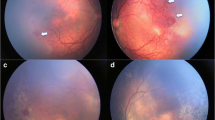Abstract
Objective : This is a hospital-based, prospective clinical study to determine the incidence, risk factors, and outcome of extreme low birth weight and very low birth weight pre-term babies with retinopathy of prematurity (ROP) at the Sultan Qaboos University Hospital, Oman.Methods : All babies with a birth weight=/ <1500 g and gestational age =/ < 32 weeks admitted in the Neonatal Unit, were screened for ROP between 4 to 6 weeks of age and staged according to the international classification and were followed up until complete vascularization of the retina. Fifty nine babies formed the study group.Results : The overall incidence of ROP was 25.4% (15 out of 59), of which 6 babies had severe ROP and underwent cryotherapy/laser. All babies with ROP had a birth weight <1250 g and were born before 31 weeks of gestation.Conclusion: ROP is a multifactorial disease, the immature retina of the pre-term baby being the primary factor. Incidence and severity was inversely proportional to birth weight and gestational age. Multiple logistic regression analysis showed that sepsis and total parenteral nutrition to be highly significant risk factors. Repeated blood transfusions, hypotension and congenital heart disease with left to right shunt were seen to be considerably associated with the development of ROP. A decrease in overall incidence and severity of ROP was observed in this study.
Similar content being viewed by others
References
Hussain N, Clive J, Bhandari V. Current incidence of retinopathy of prematurity.Pediatrics 1999; 104:1–8
Termote J, Schalij-Delfos NE, Brouwers HAA, Donders ART, Cats BP. New developments in neonatology: Less severe retinopathy of prematurity?J Pediatr Ophthalmol and Strabismus 2000; 37: 142–148.
American Academy of Pediatrics, the American Association for Pediatric Opthalmology and Strabismus and the American academy of Ophthalmology. Screening examination of premature infants for retinopathy of prematurity.Ophthalmology 1997; 104: 888–889.
The International Committee for the classification of Retinopathy of Prematurity. Multicentric trial of Cryotherapy: An international classification of Retinopathy of Prematurity.Arch Ophthalmol 1984; 102:1130–1134.
Patil J, Deodhar J, Wagh S, Pandit AN. High risk factors for development of retinopathy of prematurity.Indian Pediatr 1997; 34:1024–1027.
Bassiouny MR. Risk factors associated with retinopathy of prematurity.J Trop Pediatr 1996; 42: 355–358.
Maheshwari R, Kumar H, Paul VK, Singh M, Deorari AK, Tiwari HK. Incidence and risk factors of retinopathy of prematurity in a tertiary care newborn unit in New Delhi.National Med J India 1996; 9: 211–214.
Bullard SR, Donahue SP, Feman SS, Sinatra RB, Walsh WF. The decreasing incidence and severity of retinopathy of prematurity.J AAPOS 1999; 3: 46–52.
Lucey JF, Dangman B. A re-examination of the role of oxygen in retrolental fibroplasia.Pediatrics 1984; 73: 82–96.
Inder TE, Clement RS, Austin NC, Graham P, Darlow BA. High iron status in very low birth weight infants is associated with an increased risk of retinopathy of prematurity.J Pediatr 1997; 131: 541–544.
Hesse L, Eberl W, Schauld M, Poets CF. Blood transfusion iron load and retinopathy of prematurity.Eur J Pediatr 1997; 156: 465–470.
Brown DR, Milley JR, Ripepi VJ, Biglan AW. Retinopathy of prematurity: risk factors in a five-year cohort of critically ill premature neonates.Arch Pediatr Adolesc Med 1987; 141: 154–160.
Reynolds JD, Hardy RJ, Kennedy KA. The light reduction in retinopathy of prematurity cooperative group. Lack of efficacy of light reduction in preventing retinopathy of prematurity.N Eng J Med 1998; 338:1572–1576.
Yeo K, Perlman K, Hao Y. Outcomes of extremely premature infants related to their peak serum bilirubin concentrations and exposure to phototherapy.Pediatrics 1998; 102:1426–1431.
Blumenthal LC, Siatkowski RM, Johnson Retinopathy of prematurity in multiple gestation pregnancies.Am J Ophthalmol 1998; 125:197–203.
Palmer EA. How safe are ocular drugs in pediatrics?Ophthalmology 1986; 93:1038–1040.
Louon A, Lithander J, Reddy VG, Gupta A. Sedation with nasal ketamine and midazolam for cryotherapy in retinopathy of prematurity.Br J Ophthalmol 1993; 7: 529–530.
Author information
Authors and Affiliations
Corresponding author
Rights and permissions
About this article
Cite this article
Nair, P.M.C., Ganesh, A., Mitra, S. et al. Retinopathy of prematurity in VLBW and extreme LBW babies. Indian J Pediatr 70, 303–306 (2003). https://doi.org/10.1007/BF02723585
Issue Date:
DOI: https://doi.org/10.1007/BF02723585




